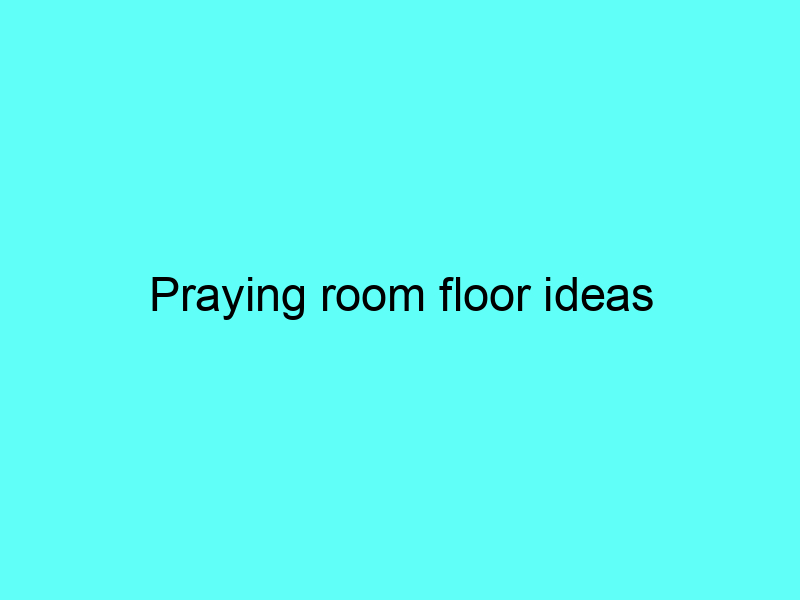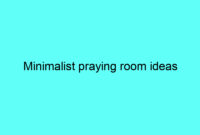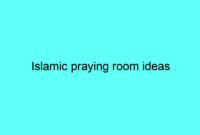“Creative Flooring Ideas for a Serene Prayer Room”
Introduction

For many people, the prayer room is the most peaceful and holy place in their home or office. It is a space that helps individuals to relax, meditate, and communicate with their higher power. Prayer rooms are not only important for religious and spiritual reasons but also for mental and physical health. They provide a sanctuary, a place to escape from the chaos of the outside world, and find inner peace. Therefore, the design and atmosphere of the prayer room should be carefully planned to create a space that encourages tranquility, reflection, and devotion. In this article, we will discuss some of the design elements that can help to create an ideal prayer room that connects individuals with their spirituality.
Elements of a Prayer Room
%2Fhow-to-create-a-prayer-room-in-your-home-4163513-02-176095fbe0ef4174bf57e2fc4a9d0a3d.jpg)
The design of a prayer room should reflect the elements that speak to the human soul. Here we mention some of the key design elements that can be incorporated into a perfect prayer room:
Color Scheme
The color scheme is the first thing that sets the tone of the prayer room. It should feel calm, soothing, and peaceful. The best colors for a prayer room are earthy tones, such as beige, taupe, and soft grey. These colors bring a sense of warmth and serenity to space. You can also add a pop of color that coordinates with the room’s overall theme, such as blue or green, which symbolize calmness and growth.
Lighting
Lighting plays a crucial role in setting the mood of the prayer room. The proper lighting can make the room feel brighter, more inviting and enhance the overall ambiance of the space. For a prayer room, the best lighting is soft, warm, and comforting. You can use charming light fixtures and table lamps to create a calm and relaxing vibe.
Flooring
The flooring of the prayer room should be comfortable and soft to the touch. The best flooring options for prayer rooms are carpet, rugs, and cork flooring. These materials help to create a cozy and soothing atmosphere and absorb sounds, making the room quieter and more serene.
Furniture and Accessories
A prayer room must have comfortable furniture, such as a cozy armchair, cushions, and blankets. These accessories help individuals to relax while meditating and provide necessary comfort while praying. You can also add elements of nature, such as flowers and plants, as they bring natural beauty and tranquility to space.
Artwork and Decor
The decoration and artwork should be inspiring and soulful. You can use religious scripture, quotes, or poems that speak to you on a spiritual level. You can also hang meaningful artwork, such as landscapes or religious symbols, as it reflects the sacred energy of the room.
In conclusion,
A well-designed prayer room can help to create a peaceful and meaningful space for relaxation and spiritual practice. The elements of color, lighting, furniture, flooring, accessories, and artwork play a crucial role in setting the tone and ambiance of the prayer room, creating a space that encourages introspection, reflection, and devotion.
Flooring Options
The floor of a prayer room is an essential feature that cannot be overlooked. It’s important to select a flooring option that is not only visually appealing but also comfortable to kneel on for long durations. Here are three flooring options suitable for prayer rooms:
1. Carpet
Carpet is a popular flooring option for prayer rooms due to its softness and comfort. It’s gentle on the knees and provides an inviting warmth to the space. A carpeted prayer room can also help to reduce noise levels and create a calming atmosphere. When considering carpeting for your prayer room, it’s essential to choose a high-quality carpet that is stain-resistant and durable. Neutral colors like beige and gray are ideal for prayer rooms as they create a soothing environment.
2. Hardwood
Hardwood flooring is a top choice for prayer rooms due to its elegance and timeless appeal. It provides a natural, warm ambiance to the space and requires minimal maintenance. Hardwood flooring is durable and can stand the test of time if cared for correctly. It’s a great investment that will last you for years to come. Choose a dark wood stain to create a cozy traditional atmosphere or light finishes for a more modern aesthetic.
3. Tile
Tile is a practical and durable option for prayer rooms. It’s easy to clean, making it ideal for high traffic areas. Tiles come in various sizes, patterns, and colors, making it easy to customize the look of your prayer room. When choosing tile flooring, opt for oversized tiles to minimize grout lines. Larger tiles can also make the room appear more extensive. Neutral-colored tiles are perfect for creating a serene environment, but bold-patterned tiles can also add a touch of personality to the space.
The type of flooring you choose for your prayer room will depend on your personal style and preferences. When selecting an option, ensure you choose a flooring material that’s durable, comfortable, and easy to maintain. A well-designed prayer room can provide a quiet escape where you can pray and meditate in peace.
Carpet

Carpet flooring has been a popular option for prayer room floors for a number of reasons. Firstly, it provides exceptional comfort underfoot, meaning that worshippers can pray for longer periods of time without experiencing discomfort or pain in their knees or feet. Secondly, carpets are highly effective sound absorbers, which is especially important in prayer rooms where silence and calmness are necessary for concentration.
Another benefit of carpet flooring in prayer rooms is that it can add warmth and a sense of cosiness to the space. Carpets come in a wide variety of colors and textures, so it’s easy to choose one that complements the decor of your prayer room. In addition, carpets are relatively easy to clean and maintain, making them a practical and long-lasting choice for any religious space.
However, one potential disadvantage of carpet flooring is that it can trap dust, dirt, and allergens, which may be harmful to individuals with allergies or respiratory issues. To minimise this risk, consider choosing a low-pile carpet and vacuuming it regularly to keep it clean.
In summary, carpet flooring offers a number of key benefits for prayer rooms, including comfort, sound absorption, warmth, and an aesthetically pleasing appearance. As with any flooring choice, it is important to consider the needs and preferences of worshippers, as well as the practical aspects of maintenance and cleaning.
Hardwood
When it comes to prayer room flooring, hardwood flooring is a popular choice. There are several benefits to choosing this type of flooring, including durability and ease of cleaning.
Firstly, hardwood flooring is known for its durability. Unlike other types of flooring, it can withstand heavy foot traffic without wearing out quickly. This is particularly important for prayer rooms, as they are places where people come to pray, sometimes several times a day. With hardwood flooring, you can rest assured that the floor will remain in good condition for a long time, even with heavy use.
Secondly, hardwood flooring is easy to clean. Unlike carpets or rugs, hardwood floors don’t collect dust or dirt easily. This makes them a hygienic choice for prayer rooms, where cleanliness is important. With a broom or a vacuum cleaner, you can easily get rid of any debris that may have accumulated on the floor. You can also clean hardwood floors with a damp mop, making it easy to maintain their shine and overall appearance.
Another benefit of hardwood flooring in prayer rooms is that it provides a classic, elegant look. Depending on the type of wood you choose, you can achieve a variety of looks, from a light, natural finish to a darker, more polished one. This allows you to create a prayer room that is both functional and aesthetically pleasing.
Finally, hardwood flooring is relatively easy to install. While it may be more expensive than other types of flooring initially, it can save you money in the long run because it requires less maintenance. Hardwood is also a great option if you live in a humid climate. Unlike certain types of tile or carpet, hardwood is less likely to hold moisture, which can cause damage over time.
In conclusion, hardwood flooring is a popular choice for prayer rooms due to its durability, ease of cleaning, classic look, and easy installation. While it may have a higher upfront cost, it can save you headaches and money in the long run by remaining durable and low-maintenance.
Tile
When it comes to choosing the flooring for a Praying room, tile flooring is a popular choice for a variety of reasons. Tile flooring is made from durable materials, like ceramic, porcelain, and stone, making it perfect for high traffic areas and ensuring it can withstand constant use over time. Additionally, tile flooring is known for its easy maintenance, making it an excellent choice for spaces that need to be kept clean, such as a Praying room.
There are many benefits of installing tile flooring in your praying room:
1. Durability
Tile flooring is extremely durable, making it an excellent choice for high traffic areas. It can withstand a significant amount of foot traffic without wearing down, unlike other flooring options like carpet or hardwood. In addition, tile is resistant to scratches and stains, making it an ideal choice for a space where spills may occur.
2. Low Maintenance
Tile flooring is easy to maintain and care for, making it an ideal choice for a Praying room. It is resistant to water, so it can be easily cleaned with water and a mop. Tile flooring also does not require any special cleaning products or chemicals, making it an eco-friendly option for those who want to reduce their environmental impact.
3. Variety of Colors and Styles
Tile flooring comes in a wide variety of colors, patterns, and styles, allowing you to choose the perfect one for your Praying room. This makes it easy to select a tile that fits your personal style and taste. Additionally, tile can be used to create intricate designs and patterns, allowing you to create a unique look for your Praying room.
4. Hypoallergenic
Tile flooring is hypoallergenic, meaning that it will not trigger allergies or asthma symptoms in people who are sensitive to dust or pollen. This makes it a great choice for people who are prone to allergies or have respiratory issues.
5. Long Lasting
Tile flooring is designed to last for a long time. Unlike other flooring materials that need to be replaced every few years, tile flooring can last for decades, making it a wise investment for a Praying room that sees regular use. This means that you will save money in the long run by not having to replace the flooring as often.
In conclusion, tile flooring offers many benefits for a Praying room, including excellent durability, low maintenance, a range of colors and styles to choose from, hypoallergenic properties, and an extended lifespan. It is no wonder that tile flooring is a popular choice among homeowners who want a durable and elegant floor for their Praying rooms.
Budget
When choosing flooring for a prayer room, budget is often a crucial factor to consider. One option for a cost-effective choice is carpet. Carpets come in a variety of colors and styles, making it easy to match the decor of the prayer room. If the prayer room is located in a high-traffic area, consider opting for commercial-grade carpet that is designed to hold up against heavy wear and tear. Another budget-friendly option is vinyl flooring. The material is affordable and easy to install, making it a popular choice for DIY enthusiasts. Vinyl flooring also comes in a range of styles, such as tile or wood-look, enabling it to mimic the look of more expensive materials while not breaking the bank.
Aesthetic Preferences
For some individuals, creating an appealing environment for prayer is essential. One material that offers a sleek and elegant touch is hardwood flooring. It not only adds beauty to the space but also helps to provide a comfortable atmosphere for sitting and kneeling. Hardwood flooring comes in a range of finishes, from light to dark, enabling homeowners to customize the look they desire. Another aesthetic option is marble tiles. Marble is often associated with luxury and class, making it ideal for a prayer room that aims to exude a sense of tranquility. Marble comes in different shades, so homeowners can choose the one that best complements the colors of the space.
Practical Needs
Practicality is essential when it comes to choosing flooring for a prayer room. One essential consideration is the maintenance required. Concrete flooring is one option that is easy to clean and incredibly durable. Polished concrete floors are a popular option, as they give the space an industrial feel while not breaking the budget. If the area is prone to moisture or humidity, consider opting for porcelain tile flooring. Porcelain is low-maintenance, slip-resistant, and has exceptional water resistance properties. Porcelain tiles come in several different colors that can complement the established decor of the prayer room.
Comfort
Comfort is another crucial consideration to make when choosing flooring for a prayer room. For those wishing for a softer surface to pray, carpet is an ideal option. Carpet is an excellent choice for comfort, as it offers a cushioned surface that is comfortable to kneel and pray on. Consider installing plush carpeting and under-padding for maximum comfort. Another soft flooring option is cork. Cork provides an advanced level of support and is environmentally friendly, making it an ideal choice for those who are eco-minded and who desire high levels of comfort.
Acoustics
High levels of soundproofing may be required for prayer rooms located in busy areas or at home with active households. One option for better acoustics is carpet, as it helps to reduce echoes and dampen sound. However, for those desiring a harder surface, consider installing cork flooring. Cork flooring is naturally sound-absorbing and provides sound insulation, making it an excellent option for those who require higher decibel-level tolerance.
Accessibility
For individuals with mobility challenges, consider investing in flooring that is easy to navigate. Hardwood floors are an ideal option as they offer a smooth and even surface that is easy to move around on. Cork is a slightly softer surface to navigate on and can aid in reducing joint strain during extended periods of prayer or kneeling. One practical option is carpet squares. These can be used to create a more accessible surface, as they provide a cushioned surface and assist in reducing slips and falls.
Tips for Choosing the Best Flooring Option for Your Prayer Room
When designing a prayer room in your home or place of worship, choosing the right flooring option is important. The floor should not only be aesthetically pleasing but also functional and safe for prayer practices. Here are some tips to help you choose the best flooring option for your prayer room:
1. Consider the Purpose of the Room
The first step in choosing the right flooring option for your prayer room is to consider the purpose of the room. Is it a room for meditation, prayer, or yoga? Will the room be used for communal prayer or individual prayer? Understanding the purpose of the room will help you choose the right flooring option.
2. Choose a Design that Calms the Mind
Your prayer room should be a place where you can find peace and relaxation. Choosing a flooring option that has a calming effect on the mind can enhance the experience of prayer. You may consider selecting a neutral color palette, natural materials, or minimalist designs that promote mindfulness and tranquility.
3. Select a Durable Option for Heavy Traffic
The prayer room may experience heavy foot traffic if it is a public or communal space. Therefore, choosing a flooring option that is durable and long-lasting is essential. Materials such as hardwood, bamboo, or stone tiles can withstand high-traffic areas and are easy to maintain and clean.
4. Ensure the Flooring is Easy to Clean
Prayer rooms should be kept clean and free from dirt and dust. The flooring option you choose should be easy to clean and maintain. Consider selecting materials that do not trap dust or are quick and straightforward to clean, such as vinyl floors, polished concrete, or tiles.
5. Choose Flooring That Enhances Acoustics
In some religious traditions, sound and music play a significant role in prayer practices. If you plan to use music or chants in your prayer room, selecting a flooring option that enhances acoustics is crucial. Certain resilient and sound-absorbing materials, such as cork, are suitable for improving sound quality and reducing echoes.
6. Ensure the Room is Safe and Slip-Resistant
The safety of the prayer room should be taken seriously. The flooring option you select should be slip-resistant and safe to walk on to avoid accidents. Carpets, rubber, and slip-resistant tiles are excellent options for ensuring safety in prayer rooms.
7. Consider Your Budget
When choosing a flooring option for your prayer room, your budget is an essential factor to consider. You don’t want to overspend and leave other design aspects of the prayer room lacking. Fortunately, there are many affordable options such as vinyl, laminate, or engineered wood that can still fulfill your design and functional requirements.
Final Thoughts
With the above tips in mind, you’ll be able to choose the best flooring option for your prayer room. Remember to choose a design that calms the mind, a durable option for high-traffic areas, easy to clean, enhances acoustics, slip-resistant, and fits your budget. Your prayer room should be a place of peace, tranquility, and comfort, and all aspects of the room should support these values.



